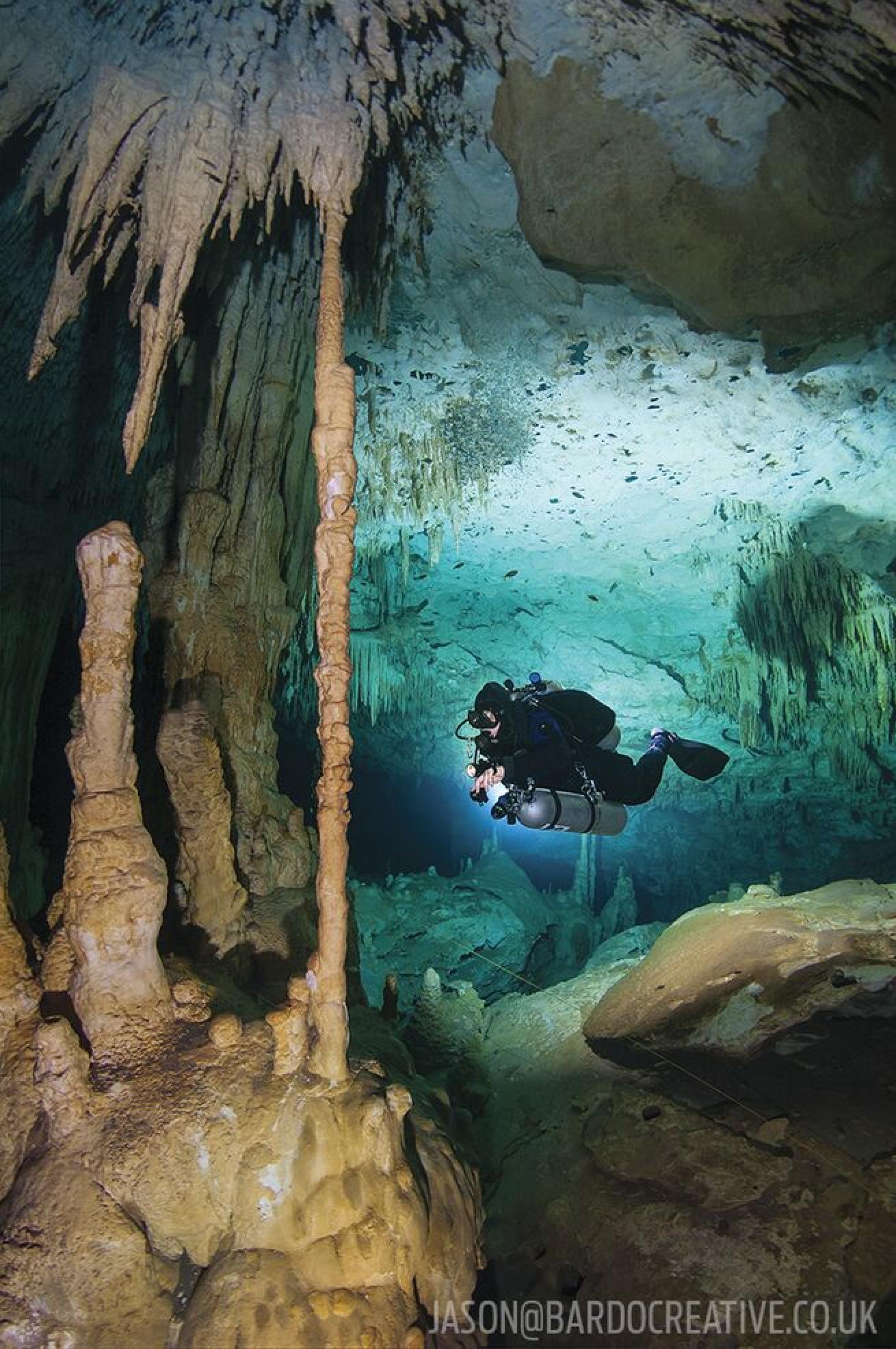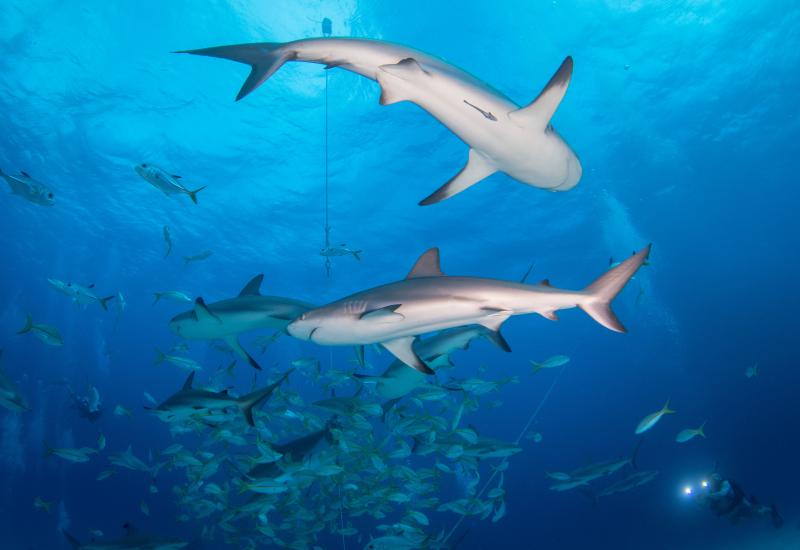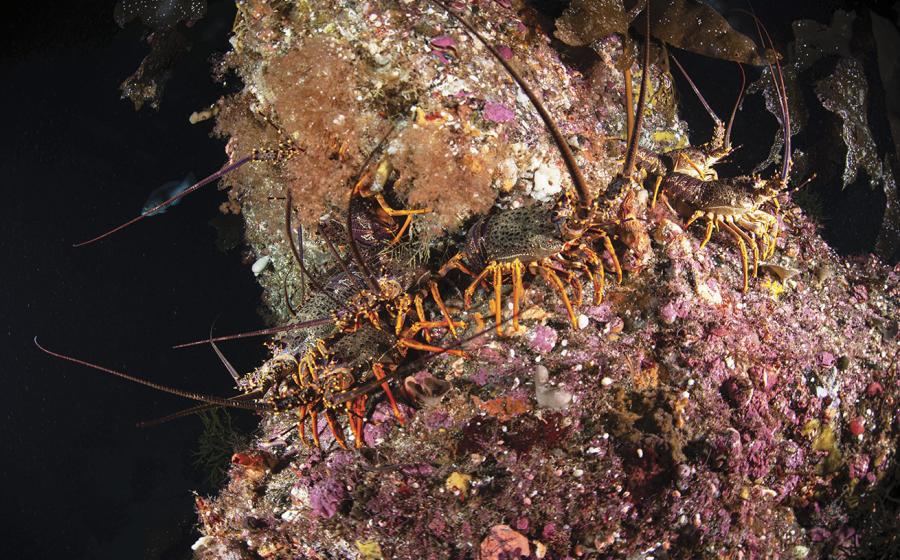The Best Secret Spots For Scuba Diving

Debbie ArriagaLush corals give way to curtains of bigeye trevally, pyramid butterflyfish and fusiliers at A Bit Far Rock in Indonesia.
1. A Bit Far Rock, Indonesia
“The Forgotten Islands are isolated even by Indonesian standards,” says Debbie Arriaga, cruise director for the liveaboard M/V Arenui, based in Indonesia’s Raja Ampat Islands. The vessel detours to this location just west of West Papua Island only in April, May, September and October. In this ultra-remote corner, Arriaga’s favorite spot to drop in is off Dawera Island, called A Bit Far Rock. “We were shown this site in October 2014 by local fishermen from the village of Dawera,” she says. “They called it a secret seamount.” Lush corals give way to curtains of bigeye trevally, pyramid butterflyfish and neon fusiliers. Appearing from behind the swaths of scales are whitetip reef sharks, gray reef sharks and the occasional silvertip reef shark. The site is worth raving about, but few get the chance. Says Arriaga, “It’s been dived by fewer than 100 divers — ever.” thearenui.com

Allison Vitsky SallmonThe Solomon Islands contains some of the world's least-touched reefs.
2. Mavis Seaplane, Solomon Islands
The site is heavily requested — but only by the scuba divers hopscotching across the Pacific to reach the Solomon Islands. The country’s more than 900 islands contain some of the world’s least-touched reefs, as well as a collection of WWII wrecks that includes 13 Japanese Kawanishi Mavis seaplanes in the central region’s Nggela island group. The liveaboard operated by Solomon Islands Dive Expeditions visits the planes, now sitting at a depth of roughly 100 feet. The most intact has lost one wing, but it’s well-preserved, with tail fins, instruments and controls intact. Says Shannon Kozak, liveaboard owner, “Narcosis starts to become an issue — but it only adds to the eeriness of the dive.” solomonsdiving.com
Related Reading: Insider’s Secret: Where the Locals Dive in the Cayman Islands
3. Daini Koyomaru, St. Lucia
On any St. Lucia dive map, you’ll find the Daini Koyomaru wreck off the southern stretch of the west coast — but that doesn’t mean you can just drop in. There is no mooring ball. Without GPS coordinates or a ride from a local scuba diving center, you won’t come close. Sunk in 1996 as an artificial reef, it now sits at a depth of 108 feet, creating a habitat for angelfish, lobsters and hawksbill turtles. Nitrox is required by operator Dive St. Lucia. divesaintlucia.com
4. Separation Head, Vancouver, British Columbia
The site called Separation Head sits amid Discovery Passage, a narrow body of water serving as a main shipping route between Washington and Alaska. It’s tucked away from the traffic — but not the tidal influence. “An enormous amount of nourishment feeds big soft corals and massive sponges,” says Pacific Pro Dive’s Bill Coltart. pacificprodive.com

It's a 20-minute trip through the to reach this secret subterranean scuba spot in Riviera Maya, Mexico.It's a 20-minute trip through the to reach this secret subterranean scuba spot in Riviera Maya, Mexico.
5. Dreamgate Cenote, Mexico
No signs mark the road to Dreamgate cenote outside the town of Tulum, in Mexico’s Riviera Maya. To visit, someone in the know must show you the way by Jeep, 20 minutes on a two-track through the jungle. Then you gear up and climb a ladder down to the entry point, pulling tanks with a rope. But the trek is worth it. Alessandra Figari, one of the owners of Cave Training Mexico, a scuba center specializing in cenote and cave diving, says, “The decorations are incredible — and the dive is a cavern, but you get what feels like a cave without being in a cave.” The spot is a museum of columns, stalactites and stalagmites, set against yellow-white and brown walls. It’s because the formations are so numerous and delicate that the location stays unmarked. Says Figari, “Only people with good buoyancy can see it because we need to protect it.” cavetrainingmexico.com

Blade, a dive site in Indonesia, is named for it's edgelike profile — a series of thin, sheer seamounts rising from the deep.Blade, a dive site in Indonesia, is named for it's edgelike profile — a series of thin, sheer seamounts rising from the deep.
6. Blade, Indonesia
The dive site Blade, so named for its edgelike profile — a series of thin, sheer seamounts rising from the deep — sits an hour’s boat ride from Wakatobi Dive Resort in southeastern Sulawesi, Indonesia. “Blade is about as picturesque as it gets,” says Karen Stearns, marketing manager for the property. Sea fans span 10 feet. Barrel sponges, crinoids and corals elbow one another for real estate on the thin foundation. Schools of snapper and barracuda circle above the rooted growth. “You could spend an entire day there, which some guests do,” says Stearns. Two couples, upon introduction to the site, elected to charter a private boat for the duration of their stay with just one target in mind. Says Stearns, “Once you see it, you understand why some people can’t help but keep going back.” wakatobi.com
7. Three Fingers, Bahamas
Only one in 10 trips aboard the M/V Aqua Cat liveaboard through the Exumas Islands of the Bahamas reaches the site called Three Fingers. “It’s so rare to see anybody even in the vicinity,” says Capt. Desmond Grayling. The topography is perhaps expected, at least in terms of its name — three long, narrow coral gardens running parallel at 33 feet — but the marine life is anything but. “A big congregation of nurse sharks nestles at this reef’s edge for protection,” says Grayling, adding that southern and yellow stingrays are also common. “It’s a phenomenal little reef oasis in a sandy desert.” allstarliveaboards.com

In the abyss, expect frequent traffic of pelagics, namely Caribbean reef sharks.In the abyss, expect frequent traffic of pelagics, namely Caribbean reef sharks.
8. Hepp's Pipeline, Grand Cayman
Grand Cayman’s north shore is wild and unpredictable, reachable by dive boat only when winds roll in from the east or south. But when conditions line up, Hepp’s Pipeline is the sweetest spot: Free-fall to a wall starting at 60 feet, scored with narrow valleys. Out in the abyss, expect frequent traffic of pelagics, namely Caribbean reef sharks and eagle rays, and on the rarest of days, a great hammerhead. cobaltcoast.com
Related Reading: The Best Scuba Diving Sites For Every Depth
9. Frigate Passage, Fiji
You’re not going to Fiji’s Frigate Passage for encounters with big animals — save that desire for Beqa Lagoon Resort’s shark dive — but for a wall studded with so many soft corals, you’d think it’s a farm of the lush invertebrates. The site — 40 minutes by boat from the resort, off a satellite island just south of Fiji’s main isle — can be experienced only when conditions permit: Heavy currents keep the corals swept of sediment but can also sweep divers right off the wall. Says Dieter Kudler, general manager of the resort: “It’s a beautifully overgrown wall, and the amount of soft corals in yellows and purples and every other color is just stunning.” beqalagoonresort.com
Bring This

SeaLife CamerasThe Whole Enchilada - The SeaLife Micro 2.0
Piecing together an underwater camera rig can be fun — but for those who prefer an all-in-one package, SeaLife released the Micro 2.0 Pro 5000. This complete setup includes the easy-to-use Micro 2.0 camera, two Sea Dragon 2500 lights, a dual tray, grips and Flex Arms. sealife-cameras.com










